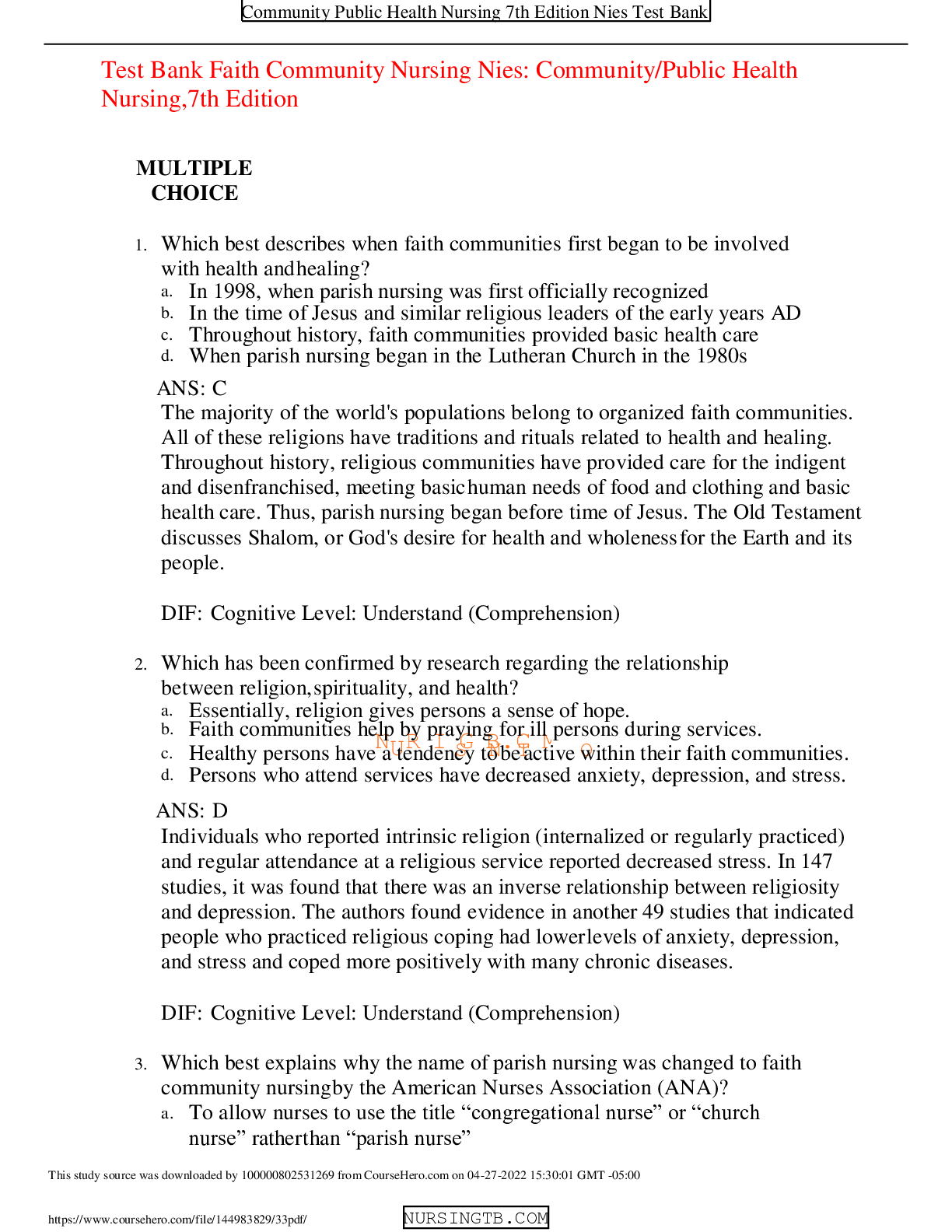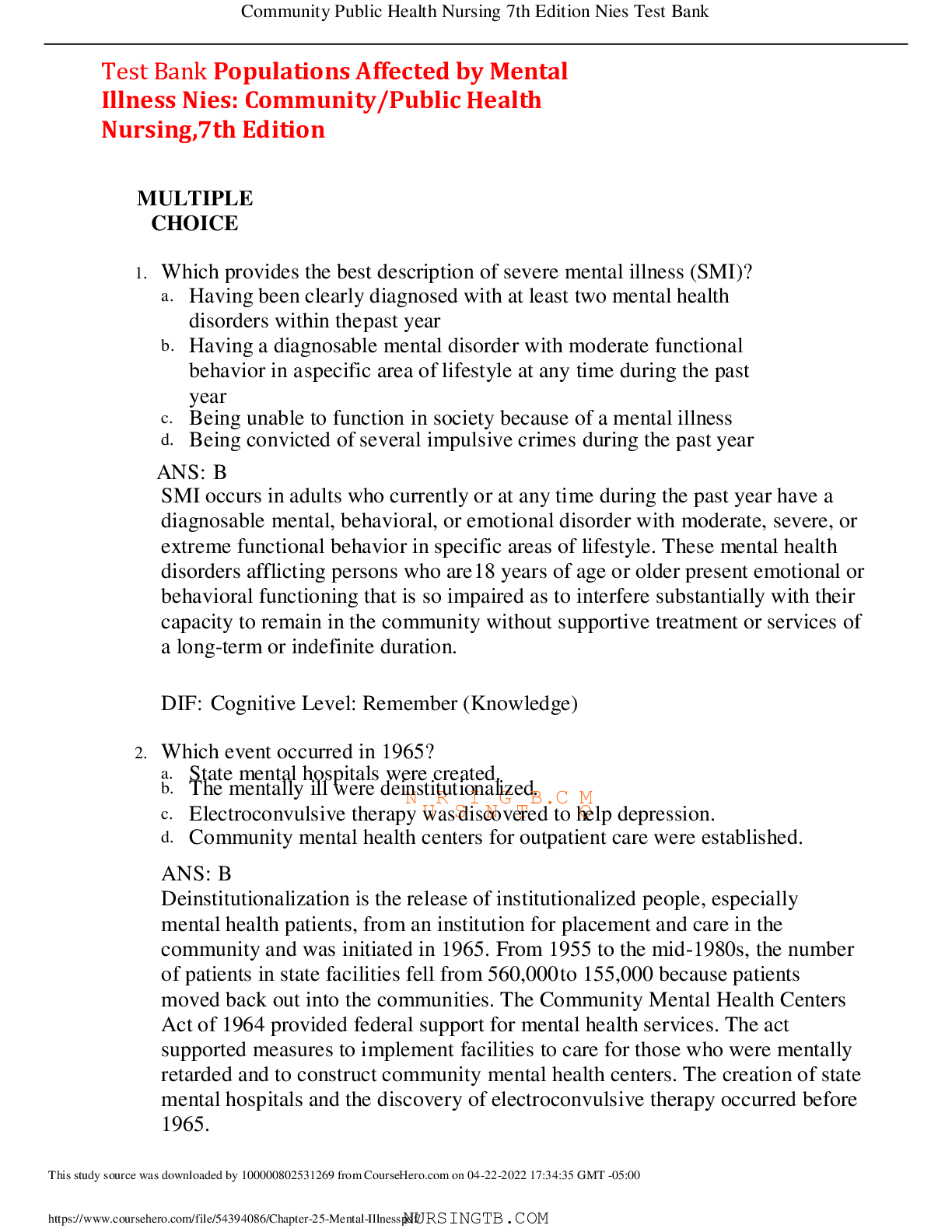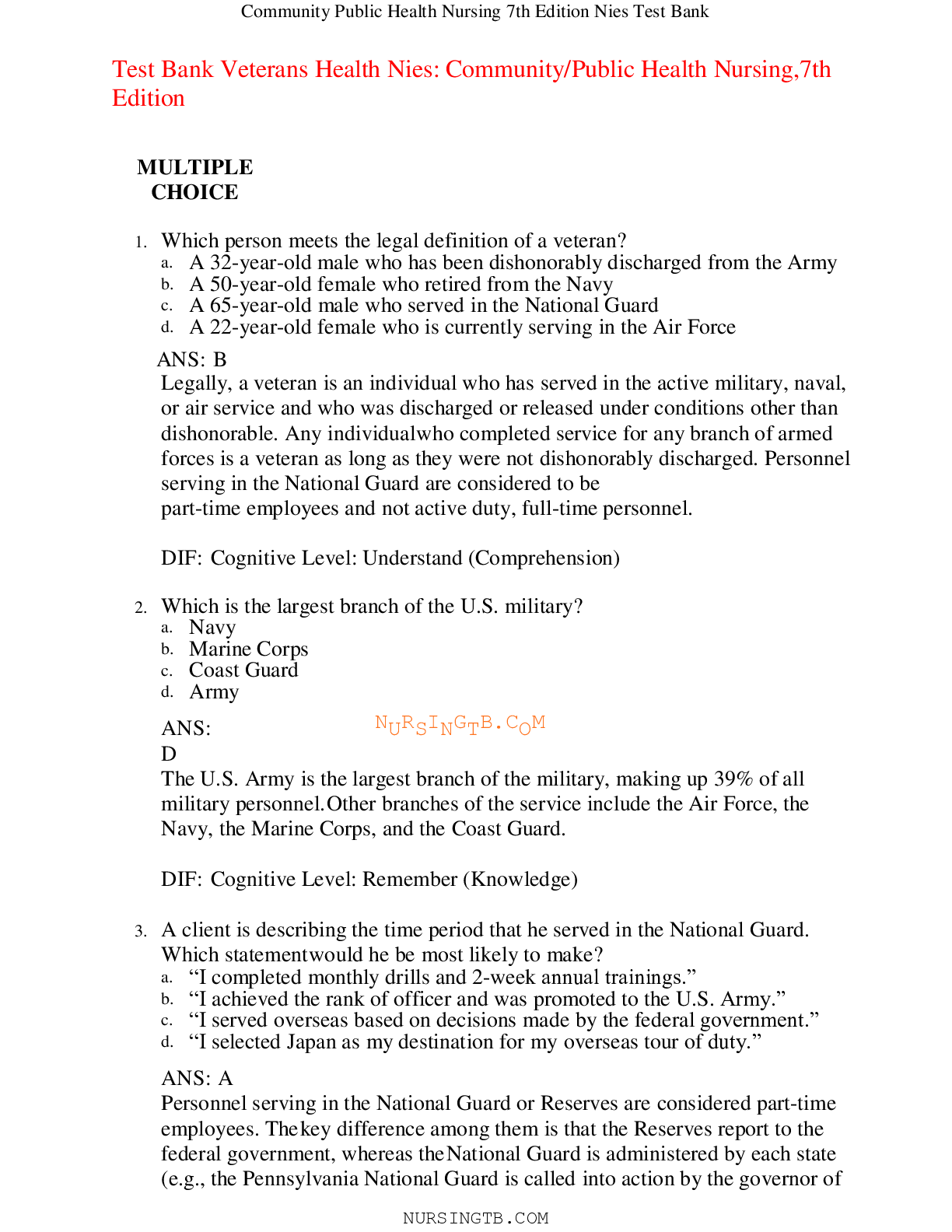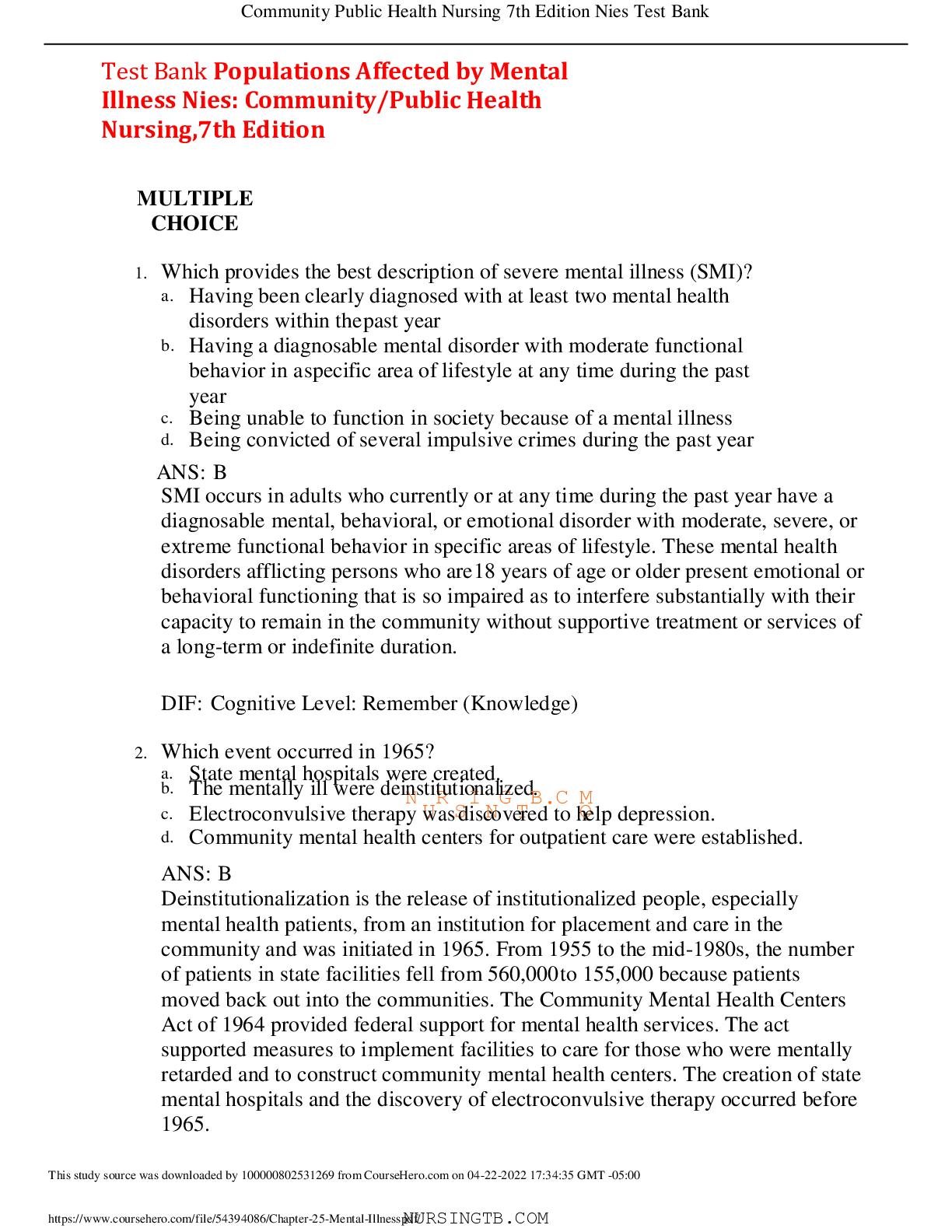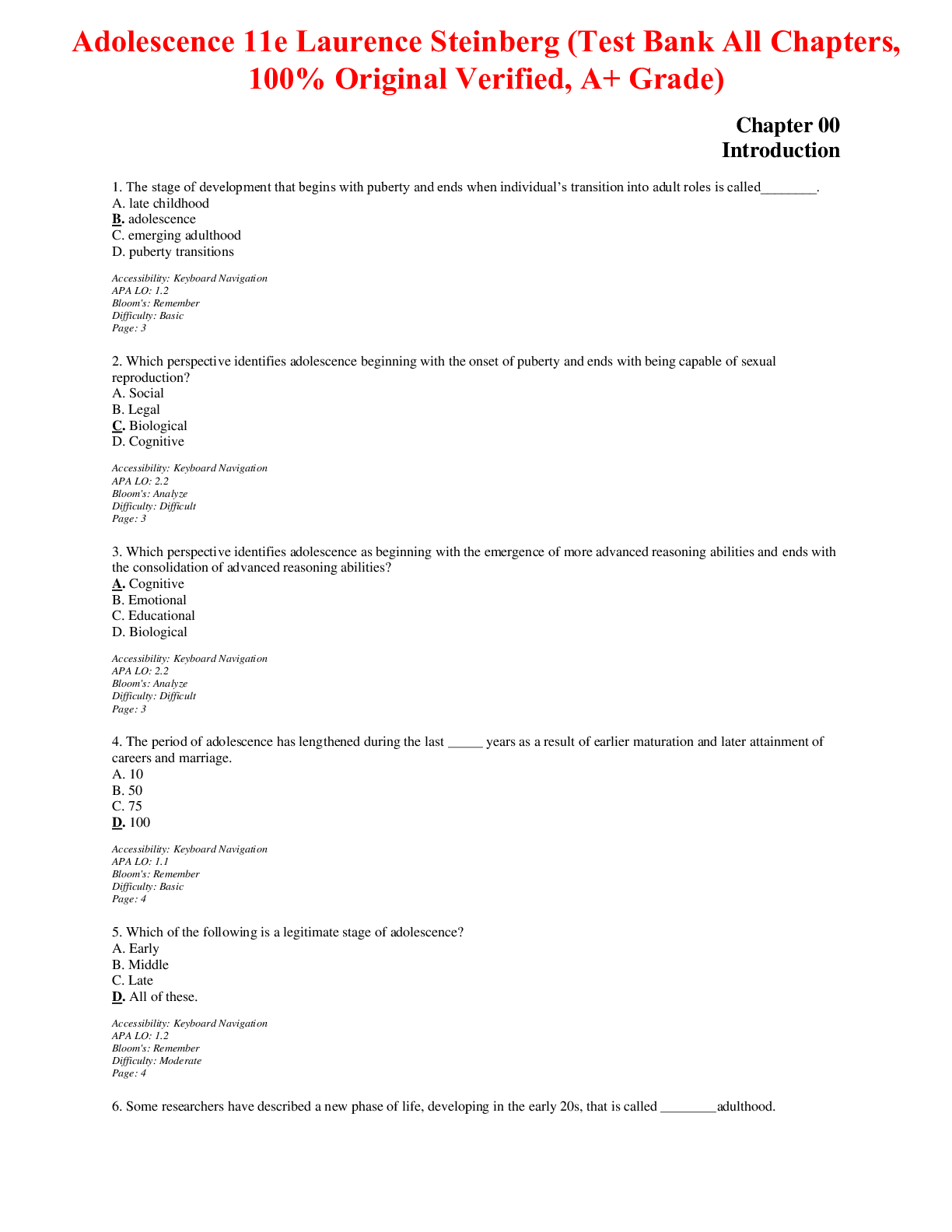*NURSING > TEST BANK > Test Bank Communicable Disease Nies: Community/Public Health Nursing,7th Edition,100% CORRECT (All)
Test Bank Communicable Disease Nies: Community/Public Health Nursing,7th Edition,100% CORRECT
Document Content and Description Below
Test Bank Communicable Disease Nies: Community/Public Health Nursing,7th Edition MULTIPLE CHOICE 1. Which infection continues to increase in the United States? a. Measles b. Pertussis c. He... patitis A, B, and C d. Sexually transmitted diseases (STDs) ANS: D Treatable STDs, such as gonorrhea, chlamydia, and syphilis, are still occurring at significant rates. Gonorrhea had plateaued or declined until 2009 but increased steadily since that time. Chlamydia, the most commonly reported bacterial disease in the United States, reached 1,441,789 cases in 2014, although some of this increase is thought to be the result of improved screening for the infection, DIF: Cognitive Level: Remember (Knowledge) 2. Which best describes what is happening with infectious diseases in the United States? a. There is a continuing decrease in vector-borne infections. b. There is a continuing increase in food-borne and waterborne infections. c. Many airborne diseases are being spread by bioterrorists. d. The rate of infection varies extensively by income and ethnic groups. ANS: D NURSINGTB.COM Probably one of the most profound failures in infectious disease control in the United States and elsewhere is that the successes are not equally distributed in the general population. Infectious diseases continue to be differentially distributed by income and ethnic groups, and the poor and minorities continue to experience the greater burden. There continues to be an increase in vector-borne infections, but there has been a decrease in food-borne and waterborne infections. There is concern that deadly pathogens will be weaponized by terrorists. DIF: Cognitive Level: Understand (Comprehension) 3. Which is a fairly recent surprise regarding infectious diseases in the United States? a. Cervical cancer and coronary artery disease may be caused by infectious agents. b. Epidemics such as the H1N1 flu continue to occur. c. Mortality caused by infectious diseases continues to rise. d. Some infectious diseases remain endemic in our society. ANS: A Recent scientific discoveries on the infectious etiology of stomach ulcers, coronary artery disease, and cervical cancer, for example, suggest that infectious agents may be responsible for more morbidity and mortality than previously recognized. Mortality caused by infectious diseases has decreased. Endemic refers to a disease that is regularly found among people in a certain area. In our society today, there are no endemic infectious diseases. Advances in public health and health care have made it easier to control infectious diseases such as H1N1 flu. DIF: Cognitive Level: Understand (Comprehension) 4. A female client develops a fungal vaginal infection after being treated with antibiotics for strep throat. Which component of the epidemiological triangle is primarily responsible? a. Agent b. Environment c. Host d. Interaction of agent and environment ANS: C Infectious diseases are the result of interaction among the human host, an infectious agent, and the environment, which surrounds the human host and where transmission is occurring. This interaction is pictured in the epidemiological triad of agent, host, and environment also discussed in Chapter 5. The antibiotic therapy eliminated a specific pathological agent, but it also may alter the balance of normally occurring organisms in the woman’s body, which caused a change in the vaginal environment, allowing normally present fungi to proliferate, resulting in a yeast infection. DIF: Cognitive Level: AnalyzNe (ARnalyIsis)G B.C M U S N T O 5. Which statement is true concerning tuberculosis (TB) infections in the United States? a. Subclinical cases of TB can occur in patients who fight off the infection and thus are not a danger to themselves or others. b. TB can be cured by a 6-month period of treatment with INH. c. TB can only be caused by the Mycobacterium bovis bacillus. d. Under certain conditions, susceptible hosts may be infected by the TB bacillus. ANS: D The principle of multicausation emphasizes that an infectious agent alone is not sufficient to cause disease; the agent must be transmitted within a conducive environment to a susceptible host. Mycobacterium tuberculosis kills cells. M. tuberculosis has low infectivity, low pathogenicity, but high virulence if untreated. DIF: Cognitive Level: Understand (Comprehension) 6. One child in a kindergarten room had a slight fever and did not eat lunch. Otherwise, the child seemed OK. Three days later, several children were absent from kindergarten. Which best describes what happened? a. Another nursery school was offering the same child care at a much lower price. b. Infectious diseases can be contagious before any diagnostic symptoms occur. c. No way to tell; there are many reasons why parents keep children home. d. Parents chose to protect their children from the child with a fever, so they kept their children home for a few days. ANS: B Frequently, the communicable period begins before symptoms are present. The communicable period, or communicability, follows latency and begins with shedding of the agent. The incubation period is the time from invasion to the time when disease symptoms first appear. Thus, even if parents kept their children away from the child with the fever, this could possibly be ineffective because their children may have already been exposed before the child exhibited symptoms. It is unlikely that the children suddenly changed schools. Although, there may be many reasons why parents keep their children home from school, in this situation there is a specific reason that can be identified. DIF: Cognitive Level: Apply (Application) 7. A daycare center asked the nurse to come because they had several children out as a result of chickenpox. Which statement should the nurse make to the staff? a. “Chickenpox has low infectivity, so few children will get sick.” b. “Chickenpox has low pathogenicity, so the children won’t be sick enough to stay home if the parents really need to go to work.” c. “Chickenpox has low virulence, so the children will be back at the daycare center in a week or so.” d. “Adults never catch chickenpox, so the staff are safe and may continue working.” ANS: C Other considerations for understanding the action of agents include their power to invade and infect large numbers of people (infectivity), their ability to produce disease in those infected with the agent (pathogenicity), and their ability to produce serious disease in their hosts (virulence). When the above concepts are applied, the chickenpox virus has high infectivity, high pathogenicity, and veryNloUwRvSirIulNenGcTe.B.COM DIF: Cognitive Level: Apply (Application) 8. A city that depended on tourist dollars had feedback that tourists were saying they were never returning because of the constant mosquito bites. Which action should be taken by the city? a. Do not have any tourist events at dawn or dusk. b. Have everyone in town search for and remove any standing stagnant water. c. Give free bug repellent to each tourist. d. Tell tourists to avoid wearing bright colors. ANS: B Knowing the reservoirs for infectious agents is important, because, in some cases, transmission can be controlled by eliminating the reservoir, such as eliminating the standing water where mosquitoes breed. The other interventions, not having events at dusk or dawn, providing bug repellent, and wearing bright colors are ways the tourists can cope with the mosquitos that are present, but they do not eliminate the breeding and presence of the mosquitos. DIF: Cognitive Level: Apply (Application) 9. The daily patrons of a local town restaurant became ill with nausea, vomiting, and diarrhea. Without knowing the cause, which action should be taken immediately to help avoid future problems? a. Establish a series of cooking classes for all citizens b. Have a citywide campaign to cover your mouth when sneezing c. Use bleach to clean the entire restaurant d. Strongly emphasize the importance of proper hand washing to staff ANS: D Agents leave the human host through a portal of exit and invade through a portal of entry. Portals of exit include respiratory secretions, vaginal secretions, semen, saliva, lesion exudates, blood, and feces. Portals of entry are associated with the portal of exit and include the respiratory passages, mucous membranes, skin and blood vessels, oral cavity, and the placenta. Because it was food poisoning of some sort, until the cause is known, it can be assumed to probably be a fecal-oral transmission. Thus, the interventions of cooking classes, covering your mouth when sneezing, and using bleach to clean the entire restaurant would be ineffective. Therefore, staff need to again be reminded of the importance of careful hand washing after using the facilities. DIF: Cognitive Level: Apply (Application) 10. Which best describes why clinical areas are so careful to ensure sanitization of surfaces and equipment between each patient? a. To avoid direct patient-to-patient transmission of infection b. To provide a clean environment for clients and staff c. To decrease transmission by fomites d. To decrease transmission by vectors ANS: C Indirect transmission is the spread of infection through a vehicle of transmission outside the host. These may be contaminNatUedRfSomINiteGs TorBv.ecCtoOrsM. Fomites can be any inanimate object, material, or substance that acts as a transport agent for a microbe (e.g., water, a telephone, or a contaminated tissue). DIF: Cognitive Level: Understand (Comprehension) 11. Which is the first step in preventing further spread of a particular sexually transmitted disease (STD)? a. Have a citywide free screening program in all high schools and colleges b. Provide public education about safe sex from abstinence to monogamous relationships c. Require all public facilities to sanitize all restrooms with a stronger, more effective agent d. Treat each infected person with the appropriate pharmaceutical agent ANS: D Antiinfective drugs, such as antibiotics, antivirals, antiretrovirals, and antimalarials, play important roles in controlling infectious diseases. Not only do they permit recovery of the infected person, but they also play a major role in preventing transmission of the pathogens to another. The first step in preventing transmission of tuberculosis and syphilis is to treat the infected person with antibiotics. Because the question asks about further spread, infection in a person has been diagnosed, so education is needed, but it is too late for that person. Adults not in school also are infected with STDs. A stronger, more effective sanitizing agent would not be the most effective strategy to prevent spread of STDs. DIF: Cognitive Level: Understand (Comprehension) 12. A case of severe acute respiratory syndrome (SARS) was diagnosed immediately on signs of illness at a tourist site in China. Which action should be taken to protect the badly needed income from tourist dollars? a. Close the airports and refuse to let the tourists in the area leave b. Begin to immunize everyone in the immediate area with protective vaccine as soon as possible c. Quarantine the ill person and use isolation techniques when providing care d. Screen everyone in the area by requiring a blood and urine sample ANS: C Quarantine is an enforced isolation or restriction of movement of those who have been exposed to an infectious agent during the incubation period; this is another method of controlling the reservoir. Quarantine was used effectively during the outbreak of SARS in 2003, when some hospitals required that their staff exposed to SARS patients remain at the hospital until proved to be symptom free at the end of the incubation period. Immunization and screening would not protect the population from exposure to this infectious disease. It is likely that others besides tourists could be exposed or infected by this disease, thus, closing airports would be ineffective in controlling the spread of the disease. DIF: Cognitive Level: Apply (Application) 13. A patient walks into a community clinic complaining of severe intestinal cramps and diarrhea. Which action can be taken to protect the staff at the clinic? a. Refuse to see anyone thatNsicRk asIclinGicsBh.avCe a Mdifferent mission than secondary and tertiary care of the obvUiousSly iNll T O b. Send the patient immediately to the closest hospital emergency department c. Treat the patient with broad-spectrum antibiotics and lots of fluids d. Use universal precautions with all patients regardless of the situation ANS: D The Centers for Disease Control and Prevention (CDC) developed a set of guidelines, called universal precautions, to prevent transmission of diseases found in blood and other body fluids. These guidelines were developed because infected people may be asymptomatic and have no knowledge of their conditions; therefore, health care workers must assume that all patients are infectious and protect themselves, other health care workers, and other patients. Refusing to treat the patient, sending the patient to an emergency department, or treating the patient with antibiotics and fluids would not be appropriate measures to protect the staff. DIF: Cognitive Level: Apply (Application) 14. During an outbreak in the hospital, all staff members were given immunoglobulin if they were not already immune to the disease. Which type of immunity will the staff who received the immunoglobulin have? a. Active immunity b. Long-lasting immunity c. Natural immunity d. Passive immunity ANS: D Passive immunity is the temporary resistance that has been donated to the host through transfusions of plasma proteins, immunoglobulins, or antitoxins, or transplacentally from mother to neonate. Passive immunity lasts only as long as these substances remain in the bloodstream. Active immunity is when the body produces its own antibodies against an antigen, from either infection with the pathogen or introduction of the pathogen in a vaccine. DIF: Cognitive Level: Apply (Application) 15. The nurse could not find a vaccine in the refrigerator. The unopened vaccine vial had been put in a storage cabinet with the other medications. The nurse drew up the appropriate dose in the syringe and then put the vial of vaccine in the refrigerator. Which would be the most likely result? a. The client will have immunity to the disease after the vaccination b. Primary vaccine failure c. Secondary vaccine failure d. The injection will not feel so cold to the client ANS: B Primary vaccine failure is the failure of a vaccine to stimulate any immune response. It can be caused by improper storage that may render the vaccines ineffective, improper administration route, or exposure of light-sensitive vaccines to light. Secondary vaccine failure is the waning of immunity following an initial immune response, often occurring with immunosuppressed and organ transplant patients in whom the immune memory is essentially destroyed. Although the injection will not feel so cold to the client, the problem that will result is primary vaccine failure. DIF: Cognitive Level: Apply N(AUpRplSicaItiNonG) TB.COM 16. A school had tried very hard to uphold the requirement for all children to be vaccinated. However, state law allowed parents to exempt their child if they had a religious reason for refusal. Two children have been diagnosed with chickenpox. Which will be the most likely result? a. Adults as well as children in the neighborhood will get chickenpox. b. All the children who played with the two sick children will probably get chickenpox. c. All the unimmunized children will probably come down with chickenpox. d. Few children will get chickenpox because of herd immunity. ANS: D Herd immunity is a state in which those not immune to an infectious agent will be protected if a certain proportion (generally considered to be 80%) of the population has been vaccinated or is otherwise immune. Because most children in the school are immune, it will be difficult for the chickenpox to spread. DIF: Cognitive Level: Apply (Application) 17. A community health clinic put a tax levy on the ballot. An angry man asks a nurse, “How can you ask me to pay taxes to buy immunizations for parents who do not want to pay for their kids to get their shots?” Which is the most appropriate response by the nurse? a. “Don’t you think ethically we should help if we can?” b. “For many of us, our faith says we have to treat our neighbor as ourselves.” c. “Only by getting almost everyone immunized can we prevent epidemics that can hurt us all.” d. “The law requires childhood immunizations, and, if parents can’t afford it, you and I will have to help pay.” ANS: C Herd immunity is a state in which those not immune to an infectious agent will be protected if a certain proportion (generally considered to be 80%) of the population has been vaccinated or is otherwise immune. If most persons are immune, it will be difficult for an infectious disease to spread. DIF: Cognitive Level: Apply (Application) 18. Which statement best explains how infectious diseases are different from any other health problem? a. Infectious diseases are easier to treat by using pharmaceuticals. b. Infectious diseases are more prevalent now than in the past. c. Infectious diseases are acute illnesses that catch clients unprepared. d. Infectious diseases have the potential to spread, creating a community emergency. ANS: D Because of their potential to spread and cause communitywide or worldwide emergencies, infectious diseases require organized, public efforts for their prevention and control. Most human diseases (e.g., cancer or diabetes) can be classified as personal health problems. Individuals with a personal health problem can be treated by the health care system one person at a time. By contrast, infectious diseases are categorized as public or community health problems. NURSINGTB.COM DIF: Cognitive Level: Understand (Comprehension) 19. Which would be one of the first steps in attempting to control a disease? a. Create an appropriate screening test for widespread use b. Define what the disease looks like in confirmed or probable cases c. Determine the disease’s portal of entry and portal of exit d. Measure the extent of its spread geographically ANS: B Standardized definitions of diseases are necessary for public health monitoring and surveillance across all levels of government. Diseases are defined and classified according to confirmed cases, probable cases, laboratory-confirmed cases, clinically compatible cases, epidemiologically linked cases, genetic typing, and clinical case definition. Once defined, disease occurrence can be compared across time, populations, and geographic areas, and appropriate control efforts can be implemented. DIF: Cognitive Level: Understand (Comprehension) 20. The charge nurse notes that two patients had communicable infectious diseases and were treated appropriately. Which action should be taken next by the nurse? a. Depends on your state health department’s requirements b. Report the two cases to the Centers for Disease Control and Prevention (CDC) c. Report the two cases to your regional health department d. Send the information for inclusion in the Morbidity and Mortality Weekly Report ANS: A Because state health departments have the responsibility for monitoring and controlling communicable diseases within their respective states, they determine which diseases will be reported within their jurisdiction. Because the state health department requirements will dictate what action is taken next, it may not be necessary to report the cases to the CDC, regional health department, or to the Morbidity and Mortality Weekly Report. DIF: Cognitive Level: Apply (Application) 21. Parents have requested that their child be brought up to date on appropriate immunizations. After reviewing the child’s medical history, the nurse prepares to give the two immunizations. What additional action should be taken by the nurse before administration of the immunization? a. Ask if there is any chance the girl child could be pregnant b. Ask the child if she consents to the immunizations c. Assess whether the child has a fever or other illness that would require the immunization be postponed d. Explain the pros and cons of obtaining immunizations to the parents e. Give the parents the Vaccine Information Statement (VIS) ANS: E The Centers for Disease Control and Prevention produces VISs that explain the benefits and risks of vaccine to vaccine recipients, their parents, or their legal representatives. Federal law requires that VISs be handed out whenever (before each dose) certain vaccinations are given. Because the parents have preNviUouRsSlyIhNadGtTheBc.hiCldOrMeceive immunizations, they clearly have chosen to continue with immunizations so they do not need to hear the pros and cons of children being immunized. Children cannot give consent, only assent, to procedures. Because the child is a minor, the child’s parents make the decisions. DIF: Cognitive Level: Apply (Application) 22. A nurse is planning primary prevention activities related to the emergence of tuberculosis (TB) in the local community. Which activity would the nurse implement? a. Offer screening tests for TB in the community b. Discuss the referral process with community members diagnosed with TB c. Educate community members about TB infection and transmission d. Monitor medication compliance for community members diagnosed with TB ANS: C Primary prevention of communicable diseases involves measures to prevent transmission of an infectious agent and to prevent pathology in the person exposed to an infection. Community education is part of primary prevention. Secondary prevention consists of activities to detect infections early and effectively treat persons who are infected. These actions prevent not only progression of the infectious disease but also transmission of the pathogen to others. Reporting infectious diseases, investigating contacts, notifying partners, finding new cases, and isolating infected people also are examples of secondary prevention. Tertiary prevention includes activities involved in caring for persons with an infectious disease to ensure that they are cured or that their quality of life is maintained. Perhaps the most important part of the treatment process is to ensure that people take their antimicrobial agents completely and effectively. DIF: Cognitive Level: Apply (Application) 23. An 11-year-old boy is at the community health clinic for his well-child visit. The child’s mother states she has heard that there is a HPV vaccine available for boys and wonders when her child should receive this vaccine. Which would be the most appropriate response by the nurse? a. “Let me check to see if we have the vaccine on hand, as boys receive a different vaccine than girls.” b. “The HPV vaccine has not yet been found to be safe and effective for boys, so I would recommend waiting another year.” c. “The HPV vaccine should be given to boys after they start puberty, so the age of administration will vary.” d. “The HPV vaccine should be given to your son at his visit today and will need to be administered two more times.” ANS: D NURSINGTB.COM Currently, the CDC recommends that both boys and girls between 11 and 12 years of age be immunized against HPV. Education is critical, because research shows that young women are three times more likely to undergo immunization if it is strongly recommended by their health care providers. Furthermore, even partial immunization, both at the individual level and within a community, has been very effective in reducing overall prevalence of HPV through the effects of herd immunity. Nurses can be central to reduction of a number of cancers by encouraging widespread use of the HPV vaccine for both males and females as recommended by the CDC. DIF: Cognitive Level: Apply (Application) MULTIPLE RESPONSE 1. Which best explains why the Vaccine Adverse Event Reporting System (VAERS) was originally legislated? (Select all that apply.) a. To ensure that data are used to educate health care professionals on proper vaccine administration b. To conduct media campaigns to help convince parents to bring their children in to receive appropriate immunizations c. To determine whether changes should be made in procedures or biological agents d. To illustrate, using actual data, that vaccines are widely given to healthy people with almost no side effects e. To monitor actual and potential vaccine-related problems f. To provide assistance to families who experience a vaccine-related injury ANS: C, E No drug is perfectly safe or effective. The VAERS allows for the monitoring of actual and potential vaccine-related problems. Changes are made on the basis of the collected data. For example, whole cell pertussis vaccine was changed to an acellular pertussis vaccine because of adverse side effects. To monitor actual and potential vaccine-related problems, health care providers must report specific postvaccination “adverse events” to the VAERS. The National Vaccine Injury Compensation Program reviews all VAERS reports and provides assistance for individuals and families who experience a vaccine-related injury, including disability and death. The VAERS does not provide education to health care professionals on proper vaccine administration or conduct media campaigns to help convince parents to bring their children in to receive appropriate immunizations. Vaccines can produce a variety of responses, both positive and negative. Thus, side effects can occur in healthy people. DIF: Cognitive Level: Understand (Comprehension) NURSINGTB.COM [Show More]
Last updated: 1 year ago
Preview 1 out of 18 pages
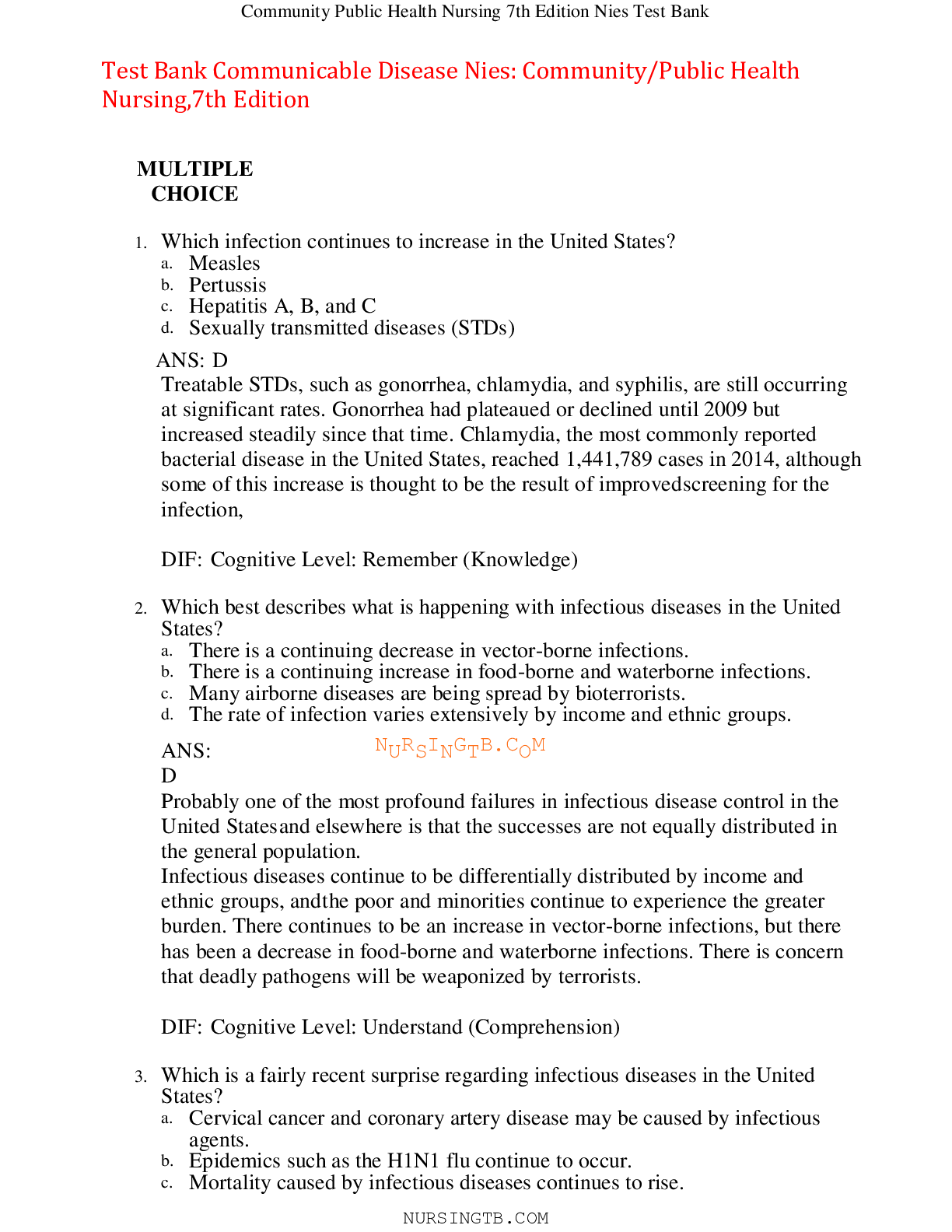
Reviews( 0 )
Document information
Connected school, study & course
About the document
Uploaded On
Apr 23, 2022
Number of pages
18
Written in
Additional information
This document has been written for:
Uploaded
Apr 23, 2022
Downloads
0
Views
38

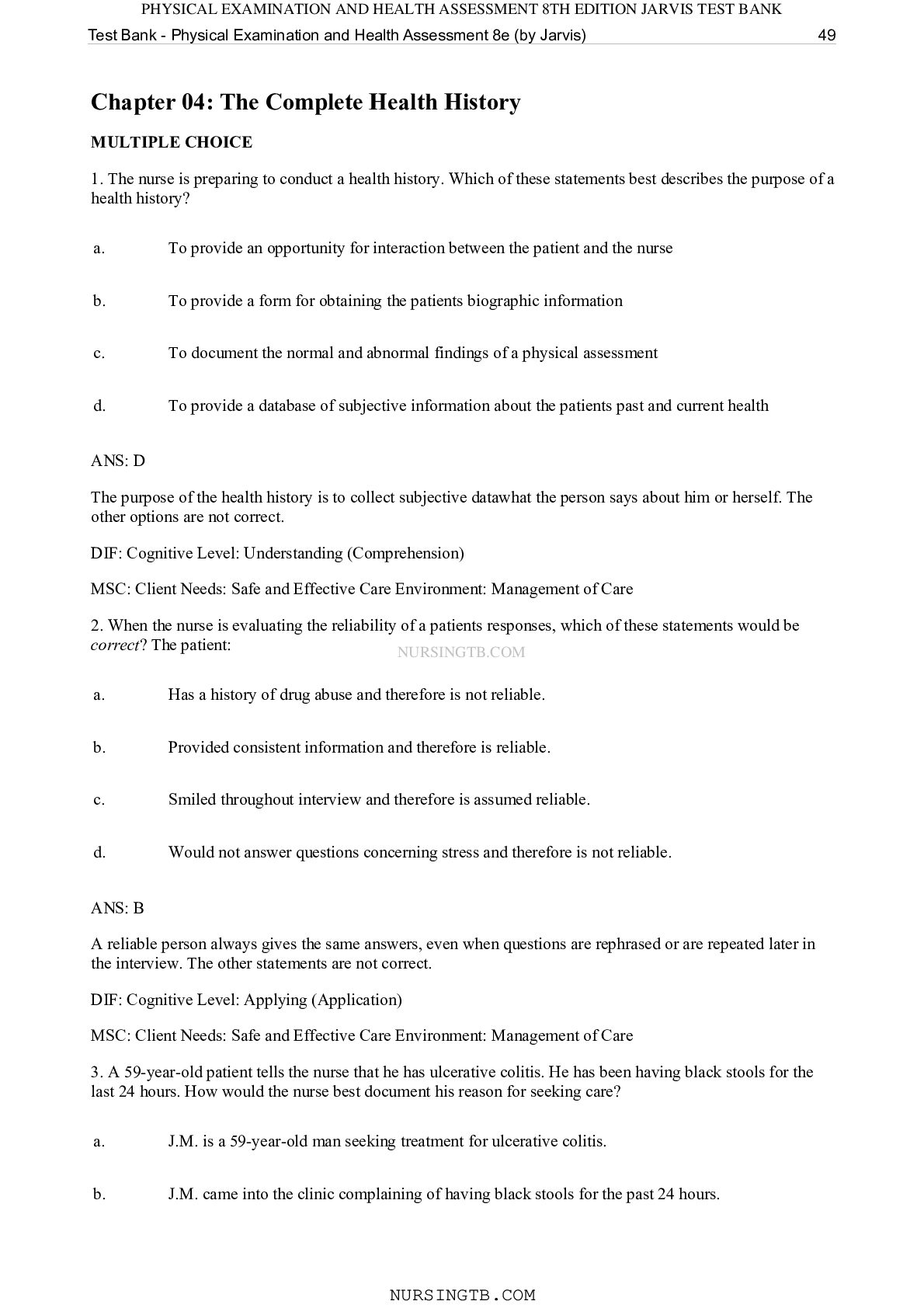











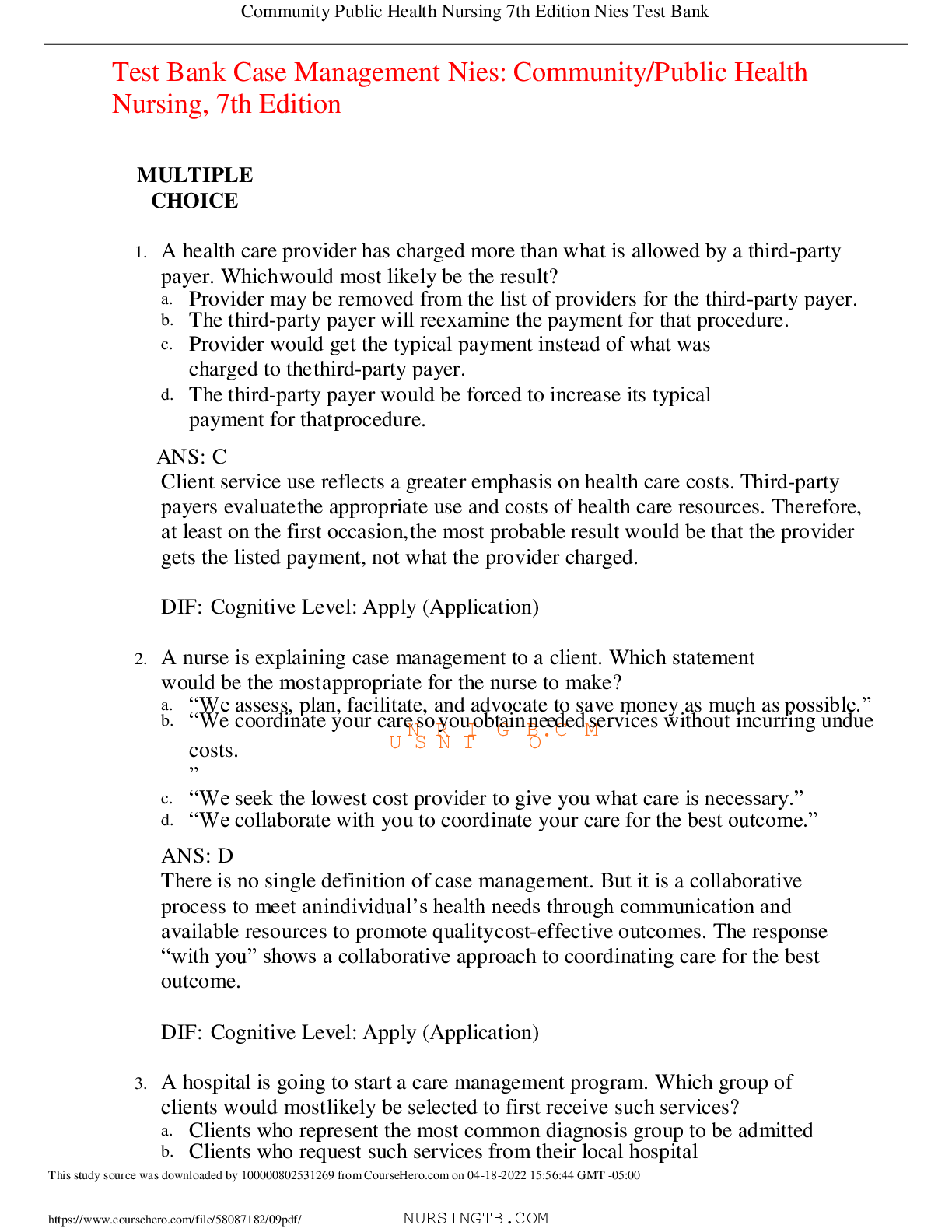

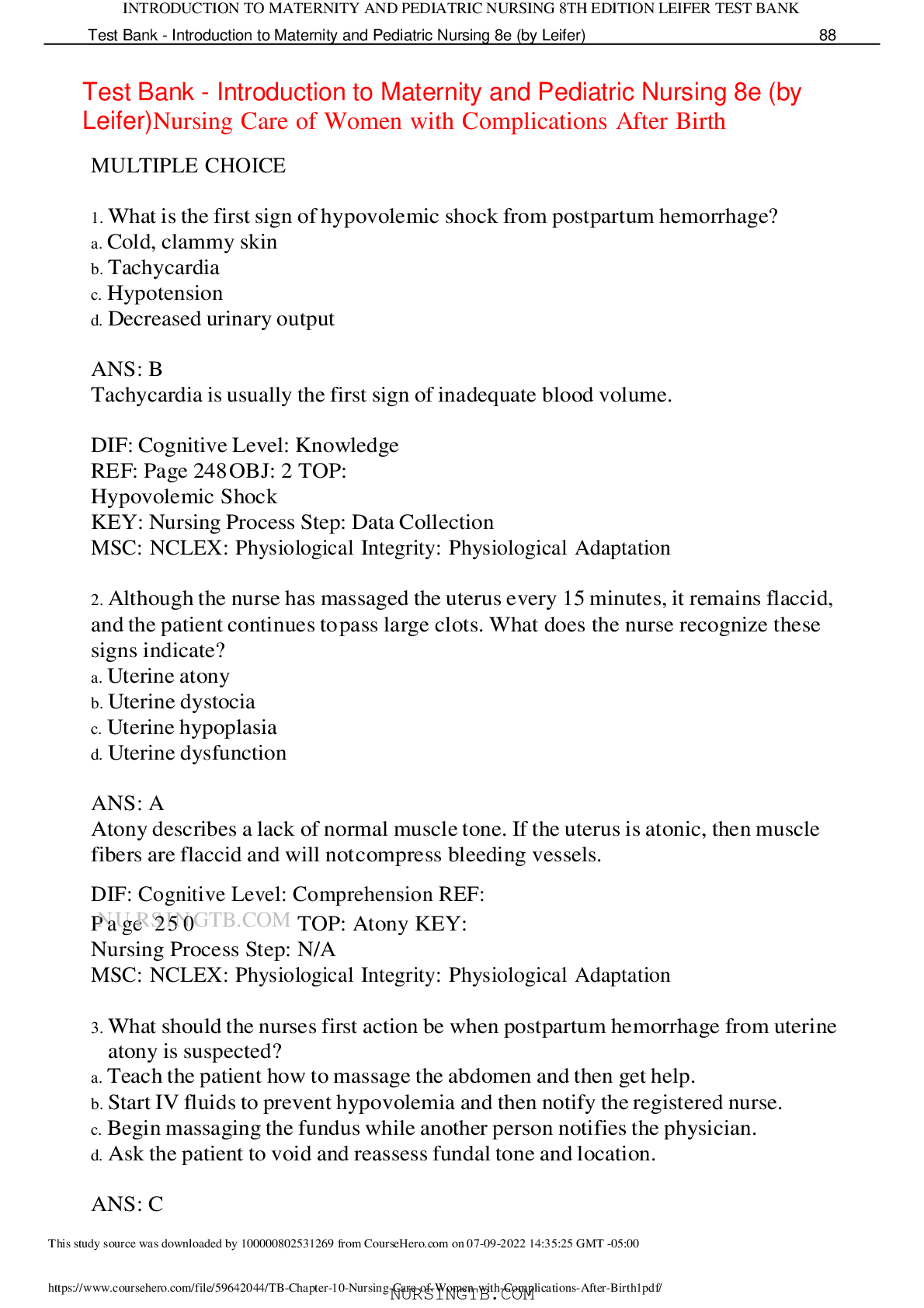

.png)
